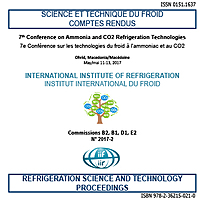
IIR document
Integrated CO2 system for refrigeration, air conditioning and sanitary hot water.
Number: pap. n. 0015
Author(s) : HAFNER A.
Summary
The manufacturers of refrigeration equipment are facing challenges related to the legislative requirements forcing them to implement less conventional refrigerants with lower Global Warming Potential (GWP) in their new products. The newly introduced next generation of hydrofluorocarbons (HFCs) with ultra-low GWPs does have a very short (atmospheric) lifetime, however, the decomposing products are highly toxic in combination with water, and distributed everywhere they do not represent a safe and sustainable alternative. Natural working fluids like CO2 have demonstrated to be an energy efficient and environmentally benign alternative. Since its fluid- and thermosphysical properties are quite different from most other working fluids, the refrigeration system designs have to be carefully adapted to the properties of CO2, thereby maximising the energy efficiency and minimising the total cost of ownership. Integrated CO2 systems can simultaneously provide refrigeration capacities at various temperature levels as low as -50 °C, Air Conditioning (AC), heating and even sanitary hot water at adequate temperature levels. A further integration of advanced thermal storage devices will enable these systems to become a valuable element within smart (thermal) grids. Examples of the latest system developments applicable in industrial- and commercial refrigeration are shown in the article.
Available documents
Format PDF
Pages: 9
Available
Public price
20 €
Member price*
Free
* Best rate depending on membership category (see the detailed benefits of individual and corporate memberships).
Details
- Original title: Integrated CO2 system for refrigeration, air conditioning and sanitary hot water.
- Record ID : 30021729
- Languages: English
- Source: 7th Conference on Ammonia and CO2 Refrigeration Technology. Proceedings: Ohrid, North Macedonia, May 11-13, 2017.
- Publication date: 2017/05/11
- DOI: http://dx.doi.org/10.18462/iir.nh3-co2.2017.0015
- Document available for consultation in the library of the IIR headquarters only.
Links
See other articles from the proceedings (42)
See the conference proceedings
Indexing
-
Increasing the performances of a CO2 refrigerat...
- Author(s) : BALLOT-MIGUET B., DEJARDINS G., QUARO B., et al.
- Date : 2019/08/24
- Languages : English
- Source: Proceedings of the 25th IIR International Congress of Refrigeration: Montréal , Canada, August 24-30, 2019.
- Formats : PDF
View record
-
Low temperature heat storages in CO2 supermarke...
- Author(s) : FIDORRA N., HAFNER A., MINETTO S., et al.
- Date : 2015/08/16
- Languages : English
- Source: Proceedings of the 24th IIR International Congress of Refrigeration: Yokohama, Japan, August 16-22, 2015.
- Formats : PDF
View record
-
Performance optimization of a transcritical CO<...
- Author(s) : KHANLOGHI M., IZADI-ZAMANABADI R., RAMEZANI H., GULLO P.
- Date : 2023/08/21
- Languages : English
- Source: Proceedings of the 26th IIR International Congress of Refrigeration: Paris , France, August 21-25, 2023.
- Formats : PDF
View record
-
Demand side management of a commercial refriger...
- Author(s) : COCCIA G., ARTECONI A., D'AGARO P., et al.
- Date : 2019/08/24
- Languages : English
- Source: Proceedings of the 25th IIR International Congress of Refrigeration: Montréal , Canada, August 24-30, 2019.
- Formats : PDF
View record
-
Experimental evaluation of ice storage inside a...
- Author(s) : MANESCU R. I., ALLOUCHE Y., HAFNER A.
- Date : 2019/04/11
- Languages : English
- Source: 8th Conference on Ammonia and CO2 Refrigeration Technology. Proceedings: Ohrid, North Macedonia, Avril 11-13, 2019.
- Formats : PDF
View record
